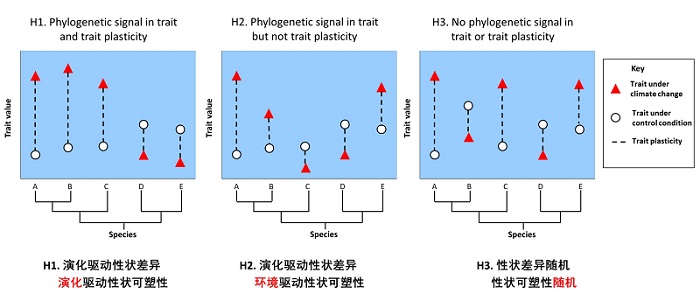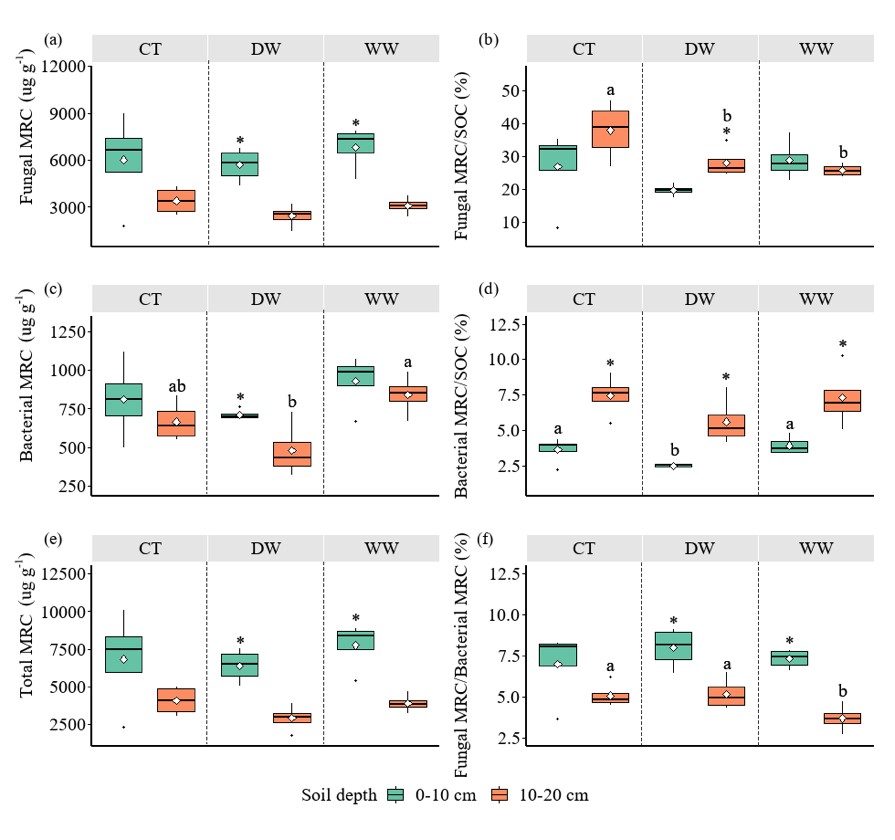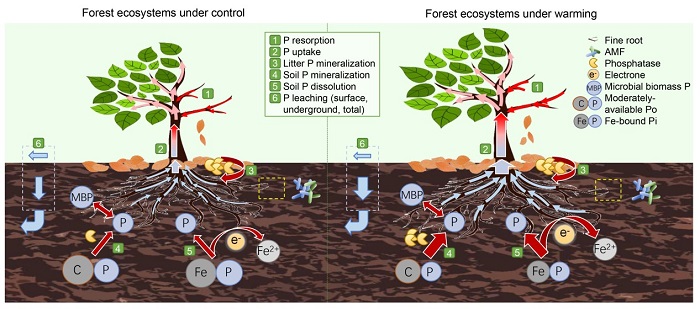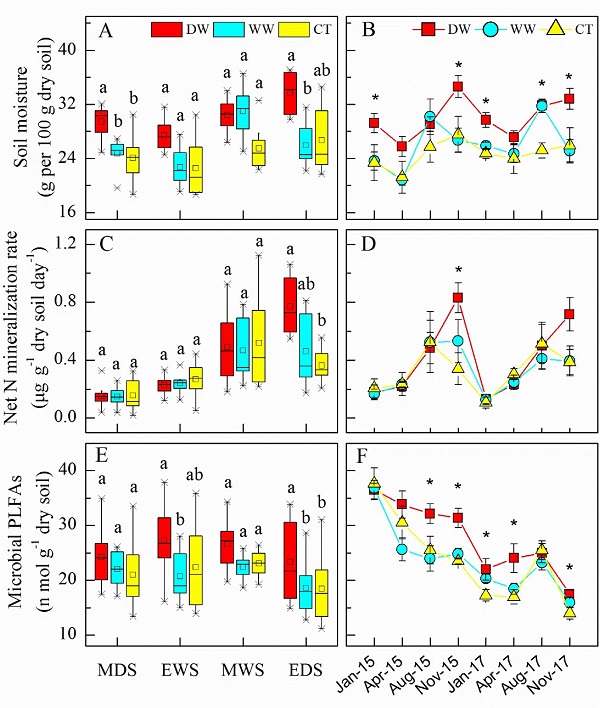News
-
2022-05-06Can evolutionary history predict plant plastic responses to climate change?Plant plastic responses are critical to the adaptation and survival of species under climate change , but whether they are constrained by evolutionary history ( phylogeny ) is largely unclear .Plant leaf traits are key in determining plants ’ performance in different environments , and if these traits and their plasticity are phylogenetically d...Read More
Plant plastic responses are critical to the adaptation and survival of species under climate change, but whether they are constrained by evolutionary history (phylogeny) is largely unclear. Plant leaf traits are key in determining plants’ performance in different environments, and if these traits and their plasticity are phylogenetically d... -
2022-04-29New progress on phylogenomic study of FagaceaYet to be sufficiently described across Fagaceae .Phylogenetic relationships and divergence time estimation of Fagaceae .Read More
Northern Hemisphere forests changed drastically since the early Eocene due to global climate change. Central to the floristic replacement with significant ecological consequence are the roughly 900 species currently recognized within Fagaceae (oak, beech, chestnut, stone oak). Fossils of modern Fagaceae are well represented in the Northern ... -
2022-04-29The effect of nature exposure, nature connectedness on mental well-being and ill-being in a general Chinese populationDisease burden .Thus , pro-mental health infrastructure and intervention are imperative .Contacts ) could reduce the incidence of mental illness and enhance mental well-being .Relationship is largely unknown .Connectedness is recommended to achieve the related psychological benefits . The lifetime prevalence of various mental disorders among Chinese population has reached up to 16.6%. The burden of mental disorders ranked the second in the overall disease burden. Thus, pro-mental health infrastructure and intervention are imperative. A large body of evidence shows that greenspace exposure (the amount of nature contacts) could...Read More
-
2022-04-20SCBG has made a new progress in the mechanism of soil organic carbon accumulation under the changes in precipitation patternsCenter for Ecology and Environmental Science of South China Botanical Garden , Chinese Academy of Sciences , studied the changes of precipitation patterns on.Rainfall in the wet season ( WW ) and a delay of the wet season into autumn ( DW ) .The platform of Xiaoliang Research Station of Tropical Coastal Ecosystems , Chinese Academy of Sciences ....Read More
Under the guidance of the professor Faming Wang, a master student at the Center for Ecology and Environmental Science of South China Botanical Garden, Chinese Academy of Sciences, studied the changes of precipitation patterns on soil organic carbon (SOC) accumulation. The study has been recently published in the journal Plant and Soil. Jing... -
2022-04-18Warming drives sustained plant phosphorus demand in a humid tropical forestPhosphorus ( P ) is often one of the most limiting nutrients in highly weathered soils of humid tropical forests and may regulate the responses of carbon ( C ) feedback to climate warming .Equivalent to a temperature change of 2.1 ° C . Results showed that warming increased P content and decreased foliar N : P . Increased plant P content was su... Phosphorus (P) is often one of the most limiting nutrients in highly weathered soils of humid tropical forests and may regulate the responses of carbon (C) feedback to climate warming. However, the response of P to warming at the ecosystem level in tropical forests is not well understood because previous studies have not comprehensively assessed...Read More
-
2022-04-15Environmental remediation promotes the restoration of biodiversity in the Shenzhen Bay EstuaryEight rivers , including the Fengtang River , flow into Shenzhen Bay . Because of population growth , urbanization , beach reclamation , tidal flat reclamation , and sewage discharge in the early development of Shenzhen City .And the Shenzhen Bay ecological restoration research subject which is funded by the Shenzhen Government . This research s... The natural resources of the South China coastal zone are as diverse as its landscape. Abundant surface runoff is enriching to coastal biodiversity. As a sea-land transit area, the interactions between multiple factors in the surrounding environment make the area more sensitive to natural changes and human activities. Shenzhen Bay is one of the ...Read More
-
2022-03-29South China Botanical Garden made progress in study of soil nitrogen mineralization response to altering seasonal precipitation distribution patternSeasonal precipitation regime plays a vital role in regulating nutrient dynamics in seasonally dry tropical forests .We found that a wetter wet season did not significantly affect soil microbes or net N mineralization rates , even in the mid-wet season ( August ) when soil water content in the WW treatment increased significantly .By contrast , ... Seasonal precipitation regime plays a vital role in regulating nutrient dynamics in seasonally dry tropical forests. Present evidence suggests that not only wet season precipitation is increasing in the tropics of South China, but also that the wet season is occurring later. However, it is unclear how nutrient dynamics will respond to the projec...Read More
-
2022-03-24South China Botanical Garden found that hydrogen-water planting can increase the content of active components in Wuzhimaotao (Ficus hirta Vahl)Wuzhimaotao ( Ficus hirta Vahl ) is a common homologous plant of food and medicine in Lingnan area of China . It is commonly used in the folk to treat diseases such as spleen deficiency , tuberculosis , weakness , rheumatism , night sweats .Because the main pharmacodynamic component of Chinese herbal medicine is usually plant secondary metabolit... Wuzhimaotao (Ficus hirta Vahl) is a common homologous plant of food and medicine in Lingnan area of China. It is commonly used in the folk to treat diseases such as spleen deficiency, tuberculosis, weakness, rheumatism, night sweats, postpartum agalactism and so on. In Guangdong, Wuzhimaotao is called "Nanqi" or "Guangdong ginseng", which is oft...Read More



